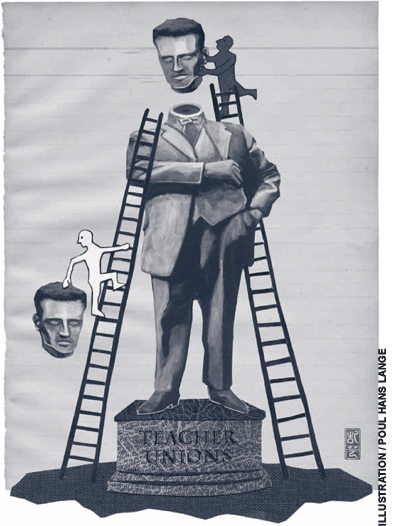 In July, the two major teachers unions entered a rare planetary conjunction, with both the National Education Association (NEA) and the American Federation of Teachers (AFT) choosing new presidents at their national conventions barely a week apart.
In July, the two major teachers unions entered a rare planetary conjunction, with both the National Education Association (NEA) and the American Federation of Teachers (AFT) choosing new presidents at their national conventions barely a week apart.
At the NEA, Dennis Van Roekel moves up to the top rung of the officers’ ladder after serving two terms as vice president, succeeding Reg Weaver. Van Roekel, 61, is a former high-school math teacher who seems to revel in his anonymity. In his acceptance speech, he said a reporter had called him a “mystery man.”
“I want to tell you [who I am],” he told the NEA delegates. “The mission and vision of this organization absolutely defined who I am, what I care about, and what I believe in.”
Randi Weingarten, 50, who adds the national presidency of the AFT to her current responsibilities as head of the United Federation of Teachers, its New York affiliate, has had much more on-stage experience in the theatre of American politics. At the 2008 Democratic National Convention in Denver, she declared, “Federal education policy must be about a lot more than testing…. When those children walk through the doors of our classrooms, they bring us their dreams, their potential and their trust. And sometimes they bring empty stomachs, untreated ailments, and life experiences that can chill you to your core.”
Besides her work with the teachers union, Weingarten has been chair of New York City’s Municipal Labor Committee, which coordinates negotiations for the city’s many public-service unions. As principal negotiator for three contentious contracts in New York, she faced down two mayors, Rudy Giuliani and Michael Bloomberg—neither one a pushover—and succeeded in winning a cumulative 43 percent raise for her teachers from 2002 to 2008. She was adept at maneuvers on the tricky three-way territory occupied by the union, the city, and the legislature upstate in Albany, which is often unsympathetic to the state’s southern metropolis.
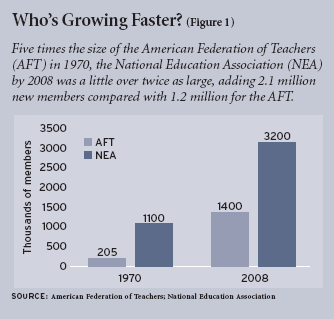 Given the unions’ public profiles, you might not even realize that the AFT, at 1.4 million members the second-largest AFL-CIO affiliate, is less than half the size of the NEA, which signs in with 3.2 million (see Figure 1). But Weingarten’s team is quite effective at orchestrating publicity.
Given the unions’ public profiles, you might not even realize that the AFT, at 1.4 million members the second-largest AFL-CIO affiliate, is less than half the size of the NEA, which signs in with 3.2 million (see Figure 1). But Weingarten’s team is quite effective at orchestrating publicity.
At the union’s own convention in Chicago, the centerpiece of Weingarten’s acceptance speech was the repudiation of the federal No Child Left Behind law (NCLB), once warmly welcomed by the AFT. Just before throwing it under the bus in her speech, Weingarten described it as “a bipartisan effort to close the gaps in educational achievement and complete the unfinished business of the 20th century.” She proposed to replace it with a sweeping vision of schools as “community schools,” providers of every service children and their families might need.
“Imagine,” she said, “schools that are open all day and offer after-school and evening recreational activities and homework assistance; high schools that allow students to sign up for morning, afternoon, or evening classes; that include child care and dental, medical, and counseling clinics or other services such as English language instruction, GED programs, or legal assistance.
“Imagine a federal law that…assures that every child learns to read by being exposed to a rich curriculum.
“Imagine if our schools had the educational resources we have long advocated, like quality pre-K, smaller classes, up-to-date materials and technology, and a nurturing atmosphere so no child feels anonymous.”
This is “Imagine” in the key of John Lennon—aspirational, rather than practical. Even though the incoming administration may be more sympathetic, and more beholden, to the teachers unions than the Bush administration (see Figure 2), there simply isn’t that kind of money floating around loose in the federal budget. Weingarten told the Chicago Tribune she couldn’t estimate how much such a plan would cost, or how many schools might be involved. But, she said, in cities where mayors have taken over the schools, the mayors could find the money.
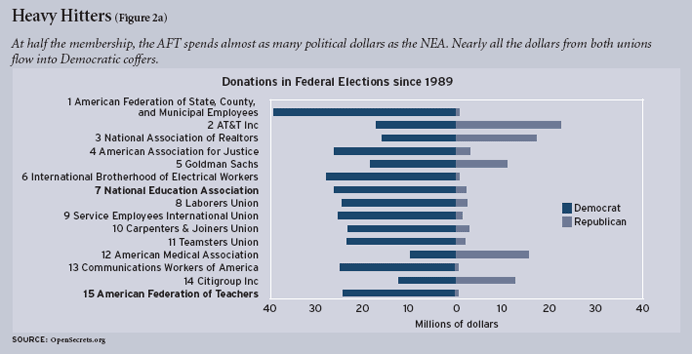
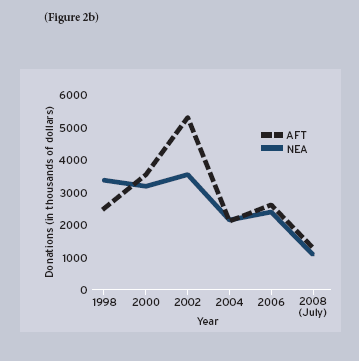
It’s good that Weingarten is opening up the social welfare debate, says Andrew Rotherham, codirector of the think tank Education Sector. The issues are how to finance it, and how to ensure good results.
Even the briefest reflection reveals this proposal doesn’t seriously address those questions. Critics were quick to point out that schools already fall short of carrying out their principal responsibility, preparing young people who graduate from high school for citizenship and for higher education or productive work. Respected independent blogger Ken DeRosa wrote at D-Ed Reckoning, “This is what we’re supposed to be imagining—allowing a dysfunctional monopoly to take over responsibilities outside of its core function. That makes little sense.”
Selling Americans on the idea that responsibility for all the rest of the social services children need should fall on those same institutions is not realistic. Even the lesser aim of dispersing a broader variety of services to neighborhood schools that are convenient to families and often underused outside school hours—and sometimes during them, in cities where enrollments are falling faster than school boards can marshal the political capital to close almost-empty schools—is problematic. Dentistry, for instance, cannot be carried out by Mark Hopkins on one end of a log and a child with a toothache on the other. A dental office is a high-tech, capital-intensive installation. Putting one in every elementary school in a large district, where most of them would be empty a lot of the time, makes no economic or professional sense.
Other problems would emerge given any serious attempt to implement such a program, especially if it were nationwide and in response to a federal mandate (or in pursuit of federal dollars, which never seem to quite cover the new responsibilities districts take on to get them). Intense lobbying would shape the law, probably for the worse. And even if a new law were a pretty good one, as laws establishing massive new federal entitlements go, it would run up against the inconvenient truth that social-service interventions, whatever their other benefits, have limited academic payoffs.
Apart from Weingarten’s unrealistic proposal, both introductory speeches amount to announcements that the new union presidents intend to do pretty much what their predecessors were doing. Both of them proclaim that without their unions there is no salvation for American education. Van Roekel told NEA delegates that as a teacher, “You soon learn that being a teacher was half the job. The other half was being part of this organization.” For those who care about the students they teach, or who want to make a difference in their lives, “education and the association work are hand in hand, one and the same.”
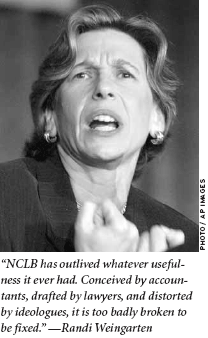
Convention speeches invite hyperbole, that’s understood—but such sentiments are insulting to teachers who believe education is their whole job, not just half of it, and who are not motivated by a desire for power, as Van Roekel admits he is. “The first time I got to be grievance chair and sat across the table from the superintendent and all those people, and I thought, man, this little math teacher is really tying up a lot of salaries on the other side of the table. And they had to listen to me.”
He adds, “I loved the feeling of the power of the collective voice, of the collective action…. Nothing good in this country has ever come except through collective action.”
Perhaps you have to crave power to persevere to the top of the NEA’s bureaucratic structure. According to the organization’s web site, before being elected NEA vice president, Van Roekel spent almost 20 years as national secretary-treasurer, a member of the national executive committee, and an officer at the local and state level in Arizona.
Weingarten is no less committed to the primacy of her union, a commitment she credits to her mother, who as an AFT member and a teacher in Nyack, New York, participated in a seven-week strike even at the cost of “material sacrifice for our family.”
“The people who do the work,” she said, “care more than anyone else, know more than anyone else, and can do more than anyone else about improving the public services that Americans count on.”
A lawyer by training, she became legal counsel to then United Federation president Sandra Feldman in 1986, was elected assistant secretary to the local union in 1995, treasurer two years later, and president in 1998 when Feldman moved on to the national presidency.
The AFT takes an expansive view of which public-service workers it can represent. Weingarten noted organizing victories for Colorado state employees (along with other unions), nurses at a medical center in New Jersey, part-time adjunct faculty at a community college, 21,000 paraprofessionals and school-related personnel in Oregon, and 28,000 home-based child-care providers in New York City—“the biggest union organizing campaign the city had seen in half a century.”
In contrast, delegates at the NEA convention voted down the leadership’s recommendation to allow private school employees to join the union, although they did approve membership for workers in private preschools.
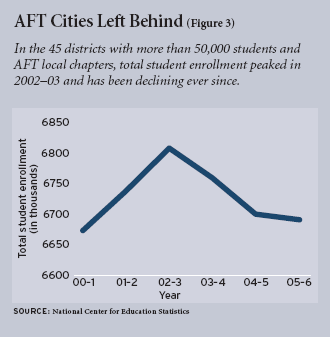
AFT may have more reason than the NEA to search far afield for new categories of employees to recruit. Mike Antonucci, whose Education Intelligence Agency bird-dogs union doings, wrote in June that almost a third of the nation’s largest school districts, the 82 with enrollment of 50,000 or more, had fewer students in 2006 than in 2001. AFT represented many districts with declining enrollments, including Weingarten’s own local in New York, down 4.9 percent. The biggest enrollment drop was in Cleveland, which fell a remarkable 22.3 percent (see Figure 3). Antonucci said he found only one large AFT district that was growing, Broward County, Florida. On the NEA side, several districts are enjoying double-digit growth, and only three—San Diego, Milwaukee, and Columbus, Ohio—are declining.
Part of the enrollment decline results from students choosing charter schools, and the AFT is trying to cover the charter school bases. The Economist noted that the AFT has successfully organized more than 70 charter schools, in 10 states. Weingarten’s New York local supports three charter schools itself, one opened just this fall.
Organizing schools one by one, though, or even a few at a time, is a tough way for a union to grow. Many charters are established by former public school teachers who left those jobs in part because they chafed under certain aspects of union contracts. And the prospects for laws compelling charter unionization, state by state, let alone federally, are not promising.
The organizations differ, but not by much, on No Child Left Behind. According to Education Week, the NEA released a list of its priorities for improving the law, including support for the teaching profession, sustained federal funding for mandates, and promotion of innovation and best practices. The union’s newest manifesto, released just before the convention, is an anti-NCLB screed titled “Great Public Schools for Every Student by 2020: Achieving A New Balance in the Federal Role to Transform America’s Public Schools.” It calls for an expanded federal role in education, which somehow or other still respects the primary role of states, districts, and schools. That is, we need more money but we don’t want you telling us how to spend it.
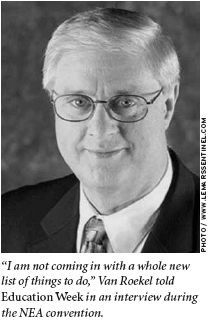
Weingarten said simply, “NCLB has outlived whatever usefulness it ever had. Conceived by accountants, drafted by lawyers, and distorted by ideologues, it is too badly broken to be fixed.”
The AFT claims to be in favor of accountability, but only if accountability takes into account “the conditions that are beyond the teacher’s or the school’s control” and the federal government provides the necessary resources. Those were excuses for failure before No Child Left Behind, and they will be again.
Van Roekel said his union remains opposed to basing teacher pay on test scores. Once again, Weingarten demonstrates the greater political skill. On the one side, she agreed with New York City mayor Michael Bloomberg to a test plan offering monetary incentives to teachers in schools whose poorest students make significant gains in achievement (see “New York City’s Education Battles,” features, Spring 2008). But then she persuaded the New York state legislature to block Bloomberg’s push to make student performance one of the criteria for awarding teacher tenure.
The mayor condemned the legislature’s response: “There’s a policy change to prevent school boards from judging teachers on whether or not they teach, and whether or not their kids learn,” he told the New York Daily News. “I happen to think that is just an outrage and it’s unconscionable.”
Teachers should be accountable just as other employees are, Bloomberg said. “All of us are judged on whether or not we do a good job, and to not judge teachers the same ways, it’s an insult to the teachers.”
The New York Times weighed in as well: “It is an absurd ban that does a disservice to the state’s millions of public school students.”
Weingarten justified the change by claiming, “There is no independent or conclusive research that shows you can accurately measure the impact of an individual teacher on a student’s academic achievement.”
That’s the kind of flat-out indefensible pronouncement that only a union official would risk making. Years of experience with value-added assessments such as the one pioneered by William Sanders in Tennessee have provided plenty of evidence that most individual teachers can be reliably compared on how effective they are at raising academic performance. But acknowledging any such obvious fact would sweep the support from under the fixed salary ladders that are the basis for teacher contracts in most districts.
So is there any prospect for reform in the near term? On the NEA side, almost certainly not.
“I am not coming in with a whole new list of things to do,” Van Roekel told Education Week in an interview during the convention. “I don’t think it’s about me; it’s about the organization. I am going to do all I can during my time to move the mission of this organization along.”
As for the AFT, Weingarten, always the more adept, called for “a bold new vision” to strengthen neighborhood schools. But so far, she hasn’t said what it might be, other than suggesting that school personnel take on the roles of social worker and distributors of medical services.
Linda Seebach retired in 2007 as an editorial writer and columnist for the Rocky Mountain News in Denver, where she frequently wrote about education.


